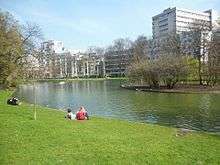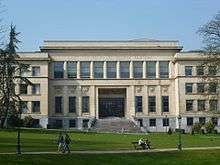House of European History
Coordinates: 50°50′18″N 4°22′48″E / 50.83833°N 4.38000°E
| House of European History | |
|---|---|
 House of European History in Leopold Park, Brussels | |
| General information | |
| Type | History museum |
| Location | European Quarter, Leopold Park, Brussels, Belgium |
| Address | rue Bélliard |
| Inaugurated | 6 May 2017 |
| Technical details | |
| Floor area | 8,000 square metres (86,000 sq ft) |
| Design and construction | |
| Architect | Atelier Chaix & Morel et Associés |
| Website | |
| historia-europa.ep.eu | |
The House of European History (HEH) is a museum in Brussels, Belgium that focuses on the history of Europe since 1789. It is an initiative by the European Parliament and opened on 6 May 2017.[1] As a cultural institution and exhibition centre, the House of European History intends to promote the understanding of European history and European integration, through a permanent exhibition and temporary and travelling exhibitions.
It houses a collection of objects and documents representative of European history, educational programs, cultural events and publications, as well as a wide range of online content. It is located in the Eastman Building near the Leopold Park in Brussels, close to the European institutions.
Origins
The idea of creating a museum dedicated to European history was launched on 13 February 2007 by President Hans-Gert Pöttering in his inaugural speech as president of the European Parliament. One of the key objectives of the project was "to enable Europeans of all generations to learn more about their own history and, by so doing, to contribute to a better understanding of the development of Europe, now and in the future."[2]
In October 2008, a committee of experts led by Professor Hans Walter Hütter, the Head of the House of the History of the Federal Republic of Germany,[3] submitted a report entitled "Conceptual Basis for a House of European History" which established the general concept and content of the project and outlined its institutional structure.
In June 2009, the Bureau of the European Parliament decided to assign the former Eastman Dental Hospital to the future museum and, in July, launched an international architectural competition. On 31 March 2011, the winning practice Atelier d'architecture Chaix & Morel et associés (FR)[4], JSWD Architects (DE)[5] and TPF (BE)[6] was appointed to carry out the renovation and extension of the building. With the backing of an expert board which brings together internationally renowned specialists chaired by Professor Włodzimierz Borodziej, a multi-disciplinary team of professionals led by historian and curator Taja Vovk van Gaal was set up within the European Parliament's Directorate-General for Communication[7] to prepare the exhibitions and the structure of the future establishment.
Collection and scope
The House of European History gives visitors the opportunity to learn about European historical processes and events, and engage in critical reflection about the implication of the processes on the present day. It is a centre for exhibitions, documentation and information which places processes and events within a wider historical and critical context, bringing together and juxtaposing the contrasting historical experiences of European people.

It is planned that the main focus of the permanent exhibition will be on European history of the 20th century and the history of European integration,[2] with additional perspectives on the main historical processes of previous centuries. The aim is not simply to present summaries of national histories, but to look at important historical phenomena from a transnational and European perspective.
The originality of the project lies, therefore, in the endeavour to convey a transnational overview of European history, while taking into account the diversity of European history and its many interpretations and perceptions. It aims to enable a wide public to understand recent history in the context of previous centuries that have marked and shaped ideas and values. In this way the House aims to facilitate discussion and debate about Europe and the European Union.
With a surface area of approximately 4,000 square metres (43,000 sq ft) at its disposal, the permanent exhibition is the centrepiece of the House of European History. Using objects and documents and an extensive range of media, it provides a journey through the history of Europe, principally that of the 20th century, with retrospectives on developments and events in earlier periods which were of particular significance for the whole continent. In this context, the history of European integration is exhibited in all its uniqueness and with all its complexity.
The House is visitor-centred, wheelchair- and pushchair-friendly and open to all, in compliance with the European Parliament's policies relating to accessibility. To that end its main offers are presented in at least 24 languages, corresponding to the official languages of the European Union at the time of opening. Given that multilingualism is an expression of the cultural diversity of Europe, the House of European History wants its visitors to experience its multilingual exhibits and services as one of the institution's main assets.
In December 2012, in the context of the Nobel Peace Prize awarded to the European Union,[8] it was decided that the Nobel medal and diploma will form part of the permanent exhibition of the House of European History, as the first objects in its collection.[9][10]
Location

The Eastman building,[11] originally designed to house a dental clinic, was named after George Eastman, the American philanthropist and inventor of the Kodak camera. His generous donations allowed the creation of dental centres in New York, London, Rome, Paris, Brussels and Stockholm, dedicated to providing free dental care for disadvantaged children.
In 1933, the Eastman Foundation approached the Swiss architect Michel Polak, known for his Art Deco style and particularly the famous Résidence Palace in Brussels, to design the new building. Inaugurated in 1935, the building is interesting both in terms of its engineering and its Art Deco elements. In the former children's waiting room there is a series of murals by the painter Camille Barthélémy illustrating La Fontaine’s fables.
The Leopold Park, containing a number of historic buildings such as the Pasteur Institute and the Solvay Library, was listed in 1976. The Eastman Building itself is not listed. The dental clinic closed its doors before the building was converted into offices for the European institutions in the 1980s.
Management and direction
The House of European History was created at the initiative of the European Parliament but is run independently.
The museum is directed by a Board of Trustees, chaired by the former president of the European Parliament Hans-Gert Pöttering. Its members include Étienne Davignon, Włodzimierz Borodziej, Miguel Angel Martinez, Gérard Onesta, Doris Pack, Chrysoula Paliadeli, Hans Walter Hütter, Charles Picqué, Alain Lamassoure, Peter Sutherland, Androulla Vassiliou, Diana Wallis, and Francis Wurtz.
The Academic Committee, chaired by Włodzimierz Borodziej, comprises historians and museum curators. Its members are Norman Davies, Hans-Walter Hütter, Matti Klinge, Miguel Angel Martínez Martínez, Anita Meinarte, Hélène Miard-Delacroix, Mary Michailidou, Hans-Gert Pöttering, Antonio Reis, Maria Schmidt, Jean-Pierre Verdier, Henk Wesseling and Oliver Rathkolb.[12] The academic team which is responsible for curating exhibitions is led by Taja Vovk van Gaal.
Estimated costs and funding
Development phase 2011–2015: €31 million[13] for the renovation and extension of the building, €21.4 million for the permanent and the first temporary exhibitions (€15.4 million for fitting-out exhibition and other spaces, €6 million for multilingualism) and €3.75 million to build up the collection. The museum is funded by the European Parliament.
Controversies
Since its initial conception, the House of European History project has been controversial, especially in the UK. The alleged "attempt to find a single unifying narrative of the histories of 27 disparate member states" has been criticised by the British think tank Civitas, saying "the House of European History can achieve nothing but a disingenuous paradox, aiming to tell the history of all the 27 states, but in fact relating no history at all."[14]
More than the museum's contents, the museum's costs have come under fire. The costs were accused of having "more than doubled",[15] the projects initial £58 million cost estimate were accused to have more than doubled to £137 million.[16] Furthermore, others have criticised the spending in times of recession, like the UKIP MEP Marta Andreasen is quoted as saying: "It defies both belief and logic that in this age of austerity MEPs have the vast sums of money to fund this grossly narcissistic project."[17]
The museum's permanent exhibition was criticised by Platform of European Memory and Conscience which accused the museum of favourable bias in relation to the portrayal of communism in the Eastern Block.[18] The Acton Institute criticised the permanent exhibition for "erasing religion" as a factor in European history.[19]
See also
References
- ↑ http://www.europarl.europa.eu/news/en/news-room/20170504IPR73468/european-parliament-opens-the-house-of-european-history-on-6-may-2017
- 1 2 http://www.europarl.europa.eu/meetdocs/2004_2009/documents/dv/745/745721/745721_en.pdf
- ↑ http://www.europarl.europa.eu/meetdocs/2004_2009/documents/dv/745/745721/745721_en.pdf
- ↑ http://www.chaixetmorel.com/
- ↑ http://www.jswd-architekten.de/
- ↑ "Archived copy". Archived from the original on 28 February 2011. Retrieved 28 February 2011.
- ↑ http://www.europarl.europa.eu/aboutparliament/en/00d7a6c2b2/Secretariat.html?tab=eParliament_secretariat_dgcomm
- ↑ https://www.nobelprize.org/nobel_prizes/peace/laureates/2012/
- ↑ http://europa.eu/newsroom/highlights/eunobel/pdf/12_en.pdf
- ↑ http://www.express.co.uk/posts/view/363773/EU-leaders-collect-Nobel-Peace-Prize-to-put-in-82m-Museum-of-European-History
- ↑ http://wikimapia.org/9859513/Eastman-Building-European-Parliament-formerly-the-George-Eastman-Dental-Institute
- ↑ http://thedanubememorial.org/wp-content/uploads/2011/10/Oliver-Rathkolb.pdf
- ↑ http://www.faz.net/aktuell/politik/europaeische-union/eu-museum-stolz-und-scham-11623924.html
- ↑ "Rewriting History". Civitas. 7 April 2011. Retrieved 11 October 2011.
- ↑ Jones, Huw (16 December 2008). "The European Parliament plans to open a museum of the continent's history from "caveman to today," officials said Tuesday". Reuters.
- ↑ Waterfield, Bruno (3 April 2011). "'House of European History' cost estimates double to £137 million". The Daily Telegraph.
- ↑ Staff (6 April 2011). "Row brewing as cost of new Brussels history museum soars". Daily Mail.
- ↑ Platform prepares critical report on the House of European History in Brussels and Platform calls for a broad debate and a change of the permanent exhibition of the House of European History, Platform of European Memory and Conscience
- ↑ The House of European History erases religion, Acton Institute
External links
| Wikimedia Commons has media related to House of European History. |